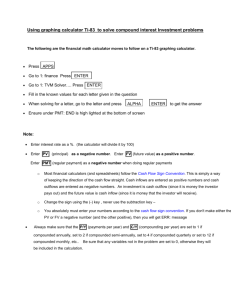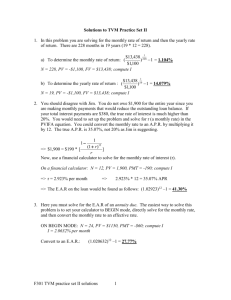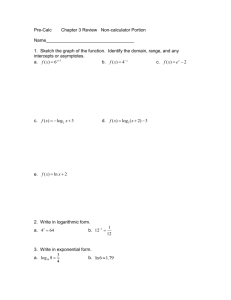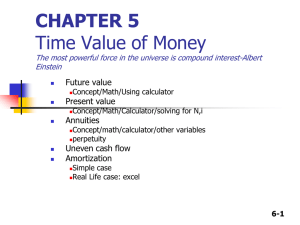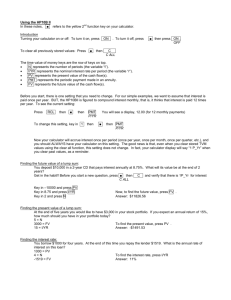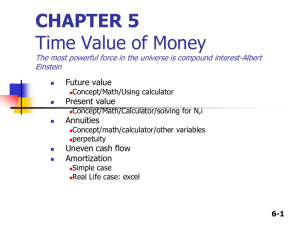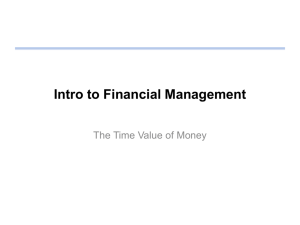Chapter 4 Part 1
advertisement
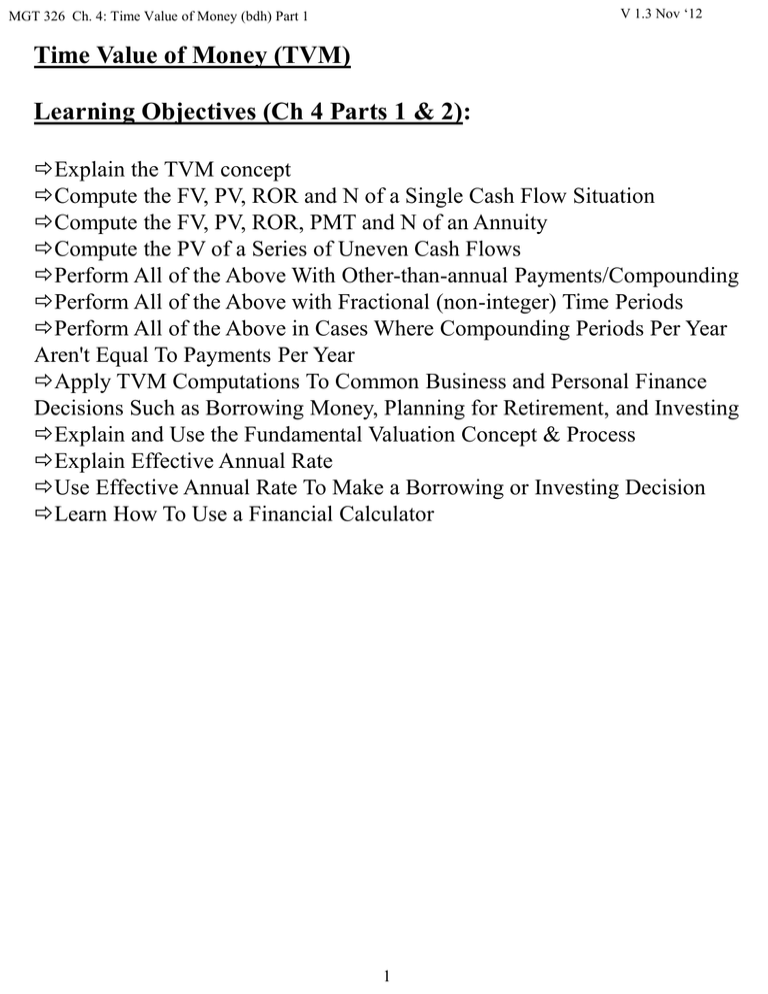
V 1.3 Nov ‘12 MGT 326 Ch. 4: Time Value of Money (bdh) Part 1 Time Value of Money (TVM) Learning Objectives (Ch 4 Parts 1 & 2): Explain the TVM concept Compute the FV, PV, ROR and N of a Single Cash Flow Situation Compute the FV, PV, ROR, PMT and N of an Annuity Compute the PV of a Series of Uneven Cash Flows Perform All of the Above With Other-than-annual Payments/Compounding Perform All of the Above with Fractional (non-integer) Time Periods Perform All of the Above in Cases Where Compounding Periods Per Year Aren't Equal To Payments Per Year Apply TVM Computations To Common Business and Personal Finance Decisions Such as Borrowing Money, Planning for Retirement, and Investing Explain and Use the Fundamental Valuation Concept & Process Explain Effective Annual Rate Use Effective Annual Rate To Make a Borrowing or Investing Decision Learn How To Use a Financial Calculator 1 V 1.2 June ‘10 MGT 326 Ch. 4: Time Value of Money (bdh) Part 1 Time Value of Money When money is some how invested (and not just placed under a mattress or in a safe), the amount of money grows Although money loses value over time due to inflation, the amount of money in an account that earns a positive ROR will be greater in the future than what it is today Thus the money in the account has different values at different points in time This is what the term “Time Value of Money” refers to The ROR should compensate for opportunity cost, inflation and risk the increasing amount of money over time should more than make up for the value lost due to inflation and opportunity costs Time Lines / Cash Flow Diagrams For the rest of this course, we will deal with cash flows that occur over some period of time It is ever so helpful to be able to depict these cash flows graphically We will use Time Lines (also called Cash Flow Diagrams) to do this because they are…. a means to visually depict cash flows, both positive and negative (incoming and outgoing) so we get a clearer idea of what’s happening a means to inventory what we know and what we don’t know about a problem a tool to help us decide on what we need to find & do in order to solve the problem Your basic Time Line (without cash flows) looks like this: 0 2 1 Today The Future Note: the time units can be what ever they need to be; days, weeks, months, years, etc. 2 3 MGT 326 Ch. 4: Time Value of Money (bdh) Part 1 Future Value: Future Value (FV) (a noun): The amount to which an investment grows when it earns a positive rate of return. Compounding (a verb): The process of going from today’s values (“present values”) to values at some future time (“future values”). Applying the effects of TVM The process of determining the Future Value of a cash flow or a series of cash flows. Converting present/previous/prior values to future values The Interest Rate/Rate of Return is the conversion factor: Example (Simple Case): You deposit $100 in a savings account that pays 6% per year (1 compounding period per year). What amount of money would you have in this account after 1 year? (What is the future value of $100 @ 6% after 1 year?) In this example, there is only one period (1 year); therefore n = 1 Interest that is paid-out over only one interest earning period is called simple interest Draw a cash flow diagram (a time line with cash flows added): PV = $100 r = 6% 0 FV = ? or this….. 1 PV = $100 r = 6% 0 1 3 FV = ? MGT 326 Ch. 4: Time Value of Money (bdh) Part 1 Example (continued): The future value includes the principle and the interest How much is the interest? Answer: Int. = Principle x Int. Rate = $100 x 0.06 = $6 How much is the future value? Answer: $100 + $6 = $106 Basic formula for finding Future Value: FV = PV(1 + r)n PV: Present Value of the principle or investment r: interest rate, Yield, ROR (the symbol k or i can also be used) n: number of periods FV: Future Value of the investment, includes the amount invested plus the return/profit for a loan, this includes the principle plus all accumulated interest The (1 + r)n portion of the formula is called the “Future Value Interest Factor” (FVIFr,n) and can be found on a FVIF table (1 + r)n is also called the “compounding” factor When “r” is used in compounding, it is referred to as the “compound rate” You can think of r as an “exchange rate” i.e. the rate at which we can exchange money today for money in the future Example: Same as before but use the basic formula to find FV. Draw a cash flow diagram: PV =$100 0 FV = ? r = 6% FV = PV(1 + r)n = $100(1 + 0.06)1 = $100(1.06) = $106 4 1 MGT 326 Ch. 4: Time Value of Money (bdh) Part 1 Solution Method 2: Use your TI BA II Plus financial calculator 1) Clear your calculator: [2nd, QUIT] 2) Clear the TVM memories: [2nd, CLR TVM] 3) Set payments per year to 1: [2nd, P/Y, 1, ENTER, CE/C] 4) Enter parameters: Enter number of periods [1, N] Enter interest rate [6, I/Y] (the calculator assumes you mean it as 6%) Enter PV [100, PV] Find FV [CPT, FV] and voila! FV = (-) $106.00 Why is FV negative? Important TVM Concept: $100 today is equivalent to $106 one year from now if the current investment opportunity is 6% and $106 one year from now (@ 6% ROR) is equivalent to $100 today Compound Interest What happens when money is left in a bank account for more than one interest paying time period (for more than 1 compounding period)? Example: You deposit $100 in a savings account that pays 6% per year. What amount of money would you have in this account after 2 years? (What is the future value of $100 @ 6% after 2 years?) (Abbreviation notation: FV100,6%,2yr) Draw a cash flow diagram: PV = $100 r = 6% 0 1 2 FV = ? 5 MGT 326 Ch. 4: Time Value of Money (bdh) Part 1 Compound Interest (continued) Example (continued) The account collects interest after one year ($6 as per previous example) which results in a balance of $106 (FV1 = $106) During the second year, interest is paid on the one year balance (i.e. the $106 earns 6% interest) FV2 = $100(1 + 0.06)(1 + 0.06) FV1 FV2 = $100(1 + 0.06)2 = $112.36 When an investment is held for more than one interest paying period, the interest is “compounded” (interest is paid on previously earned interest as well as on the principle) Each interest paying period is called a “compounding period” In this context, “r” is referred to as the “compound rate” Solution Method 2: Use the financial functions on your calculator 1) Clear TVM Memory: [2nd, CLEAR TVM] 2) Set/ensure payments per year = 1: [2nd, P/Y, 1, ENTER, CE/C] 3) Enter parameters: Enter number of periods [2, N] Enter interest rate [6, I/Y] (calculator interprets it as 6%) Enter PV (100) [100, PV] Find FV [CPT, FV] and voila! FV = (-) $112.36 6 MGT 326 Ch. 4: Time Value of Money (bdh) Part 1 Example (continued) Here’s an explanation of what happened at each time period Cash Flow Diagram as Normally Drawn PV 0 1 2 FV Cash Flow Diagram Showing Implied Interest Payments PV 1 2 Interest Payments (Implied & Not Drawn) FV Cash Flow Diagram Showing Period-to-Period Earnings & Balances r = 6% PV 0 Beginning Balance: Interest Earned: Ending Balance: $100.00 $0.00 $100.00 1 2 $100.00 $6.00 $106.00 $106.00 $6.36 $112.36 = $100.00 x (1 + 0.06) = $106.00 x (1 + 0.06) 7 FV + 0 + FV = MGT 326 Ch. 4: Time Value of Money (bdh) Part 1 Example: What is the FV of $5000 @ 6% after 5 years? (Find FV5000,6%,5) FV = ? r = 6% 0 1 2 3 PV = 5,000 Formula Solution: Calculator Financial Function Solution: 8 4 5 MGT 326 Ch. 4: Time Value of Money (bdh) Part 1 Future Value as a Function of Time and Rate of Return Future Value of $1 $5 r = 15% $4 $3 r= 10% $2 r = 5% $1 r = 0% 0 2 4 6 8 10 Number of Periods Key Points: The greater the interest rate/rate of return, the bigger the future value The longer the investment is held, the bigger the future value Which factor (r or time) has the greatest influence on FV? 9 MGT 326 Ch. 4: Time Value of Money (bdh) Part 1 Present Value: Money that is expected to be received or paid in the future does not have the same value as today’s money because of TVM In order to determined what future money is worth in terms of today’s dollars, we have to reverse the effects of TVM; this is referred to as discounting Present Value (PV) (a noun): the value today (the value in "today's dollars") of a future cash flow or series of cash flows. Discounting (a verb): The process of going from future values to present values. (The “reverse” of compounding.) Reversing the effect of TVM The process of finding the Present Value of a future cash flow or series of cash flows. Converting future dollars into “today’s” dollars Basic formula for finding Present Value: PV = FV / (1 + r)n The 1/(1 + r)n portion of the formula is called the “Present Value Interest Factor” (PVIFr,n) and can be found on a PVIF table 1/(1 + r)n is also called the “discounting” factor When “r” is used to discount, it is referred to as the “discount rate” 10 MGT 326 Ch. 4: Time Value of Money (bdh) Part 1 Present Value: Example (Simple Case): What is the Present Value of $200 discounted for 1 year @ 4% per year? (Abbreviation notation: PV200,4%,1) In other words, how much would we have to deposit today into an account that pays 4% per year in order to have $200 one year from now? Draw a cash flow diagram: FV = $200 r = 4% 0 1 PV = ? Solution Method 1: Use the Formula PV = FV / (1 + r)n = $200 / (1 + 0.04)1 = $200 /(1.04)1 = $200 / 1.04 = $192.30 Solution Method 2: Use your financial calculator 1) Clear TVM Memory: [2nd, CLEAR TVM] 2) Set/ensure payments per year = 1: [2nd, P/Y, 1, ENTER, CE/C] 3) Enter parameters: Enter number of periods [1, N] Enter interest rate [4, I/Y] Enter FV [200, FV] Find PV [CPT, PV] and voila! PV = (-) $192.30 Why did we use 4% to discount the future cash flow? Answer: It is the specified compound rate It is the rate at which we expect our investment to grow to achieve a future value Since discounting is the opposite of compounding, we must discount at that exact same rate in order to find the present value 11 MGT 326 Ch. 4: Time Value of Money (bdh) Part 1 Example: What’s the PV of $5000 discounted for 3 years @12%? (Find PV5000,12%,3) PV = ? 0 2 1 r = 12% 3 FV = $5000 Formula Solution: Calculator Financial Function Solution: Here’s an explanation of what happened at each time period 0 2 1 r = 12% 3 PV Beginning Balance: Interest Earned: Ending Balance: $3,558.90 $0.00 $3,558.90 $3,558.90 $427.07 $3,985.97 = $3,558.90 x (1 + 0.12) $3,985.97 $478.32 $4,464.29 = $3,985.97 x (1 + 0.12) $4,464.29 $535.71 $5,000.00 = $4,464.29 x (1 + 0.12) FV 12 MGT 326 Ch. 4: Time Value of Money (bdh) Part 1 Very Important Financial Concepts: Re-word the example from p. 12: You are considering purchasing a security that promises to pay $5,000 three years from now. What is this security theoretically worth today (or….. what is its fair market value?) if your best investment opportunity yields 12%? Answer: $3,558.90 Financial Valaution Principle: The present value of any financial asset depends on usable, after-tax cash flow it is expected to produce in the future But, due to the Time Value of Money, we have to discount those expected future cash flows in order to convert them into today’s dollars. Thus: The overriding, all important, never-to-be-forgotten Financial Valuation Process is: The theoretical value (fair market value or “no-arbitrage” price) of any financial asset is determined by discounting all future expected cash flows to the present (i.e. find the PV @ t = 0 of all cash flows) and adding them up This is the present value of the asset. This is what the asset is theoretically worth today, without profits, fees or other transaction costs This is the fair market value/no-arbitrage price of the asset today, without profits, fees or other transaction costs 13 MGT 326 Ch. 4: Time Value of Money (bdh) Part 1 Use the Financial Valuation Process to Make a Decision Example: Consider two different investment options: -Option A: For an initial cost of $9,000 you receive $12,600 at the end of four years. -Option B: For an initial investment of $20,000 you receive $26,000 at the end of four years -Your best investment opportunity yields 6% p.a. ( per annum). Which is the best investment option? Step 1: Find the present value of the future cash flows of both options Option A: N=4, I/Y=6, FV=12600, CPT PV: PV = $9,980.38 Option B: N=4, I/Y=6, FV=26000, CPT PV: PV = $20,594.44 Step 2: Compute the net profit from each investment (Discounted Future Cash Flows – Initial Costs) Option A: $9,980.38 - $9,000 = $980.38 Option B: $20,594.44 - $20,000 = $594.44 Answer: Option A is the better investment Net Profit (Discounted Future Cash Flows – Initial Costs) is also called Net Present Value (NPV) NPV = PV of Benefits – PV of Costs Read Section 3.5 in your text book Point: This is a fundamental way to make a financial decision Important TVM Rule: It is only possible to compare or combine values at the same point in time i.e. if you want to compare or combine values, they must have the same time value of money (they must be in terms of t = 0 dollars or t = 5 dollars or t = 10 dollars, etc.) 14 MGT 326 Ch. 4: Time Value of Money (bdh) Part 1 Other Key Points: Compounding means we're making numbers bigger; we're growing it; we're going to the right on the timeline FVs are bigger numbers than PVs; check your answer Discounting means we're making the numbers smaller; we're shrinking it; we're going to the left on the time line PVs are smaller numbers than FVs; check your answer Compounding 0 Discounting 15 1 MGT 326 Ch. 4: Time Value of Money (bdh) Part 1 Solving for Interest Rate (or IRR) Example: Your broker proposes an investment scheme that will pay you $1000 one year from now for an initial cost of $900 today. What is the annual return on this investment? Draw a cash flow diagram FV = $1000 r = ?% 0 1 PV = $900 Solve for r using the PV (or FV) formula: FVn = PV(1 + r)n $1000 = $900(1 + r)1 $1000/$900 = (1 + r)1 (1.1111)1 = 1 + r r = 1.1111 - 1 r = 0.1111 = 11.1111% per year Calculator Financial Function Solution: 1) Clear your calculator: [2nd, CLEAR TVM] 2) Set/ensure payments per year = 1: [2nd, P/Y, 1, ENTER, CE/C] 3) Enter parameters: Enter number of periods [1, N] Note: One of the two cash inputs must be negative Enter PV [900, +/-, PV] Enter FV [1000, FV] Find I/Y [CPT, I/Y] and voila! I/Y = 11.1111% per year Solution Method 3: (New - Old) / Old = (1000 - 900) / 900 x 100% = 11.1111% 16 MGT 326 Ch. 4: Time Value of Money (bdh) Part 1 Solving for Interest Rate (or IRR) Example: Your broker proposes an investment scheme that will pay you $1000 two years from now for an initial cost of $900 today. What is the annual return on this investment? FV = $1000 r = ?% 0 2 1 PV = $900 Solve for r using the PV or FV formula: FVn = PV(1 + r)n $1000 = $900(1 + r)2 $1000/$900 = (1 + r)2 (1.1111)1/2 = 1 + r r = 1.054093- 1 r = 0.05493 = 5.4093% per year Calculator Financial Function Solution: Important Point: Rates of Return are always expressed on an annual basis. Why? Why can’t you use (New-Old) / Old? (New - Old) / Old = (1000 - 900) / 900 x 100% = 11.1111% This is the return over 2 years, not an annual rate 17 MGT 326 Ch. 4: Time Value of Money (bdh) Part 1 Example: Your broker proposes an investment scheme that will pay you $1000 two years from now for an initial cost of $900 today. What is the total return on this investment? (New - Old) / Old = (1000 - 900) / 900 x 100% = 11.1111% Why don’t you just multiply the annual rate of return (5.4093%) by 2 (to produce 10.8186%) ? Solving for the number of periods (n) Example: How long will it take to double an investment of $1000 @ 6% annual interest? FV = $2000 r= 6% 0 n=? PV = $1000 Solve for n using the PV (or FV) formula: FVn = PV(1 + r)n 2000 = 1000(1 + 0.06)n 2000/1000 = (1.06)n LN(2) = LN(1.06)n n = LN(2)/LN(1.06) = 0.6931 / 0.05827 = 11.90 years Calculator Financial Function Solution: 1) Clear your calculator: [2nd, CLEAR TVM] 2) Set/ensure payments per year = 1: [2nd, P/Y, 1, ENTER, CE/C] 3) Enter parameters: Enter I/Y [6, I/Y] Note: One of the two cash inputs Enter PV [1000, +/-, PV] must be negative Enter FV [2000, FV] Find N, [CPT, N] and voila! N = 11.90 18 MGT 326 Ch. 4: Time Value of Money (bdh) Part 1 Annuities Definition: a series of equal payments made at fixed intervals for a specified number of periods Examples: Trust Fund Endowment (PV) Pmt Pmt Pmt 0 1 2 3 Pmt Pmt Pmt 1 2 3 Pmt 0 Endowment (PV) Loan Principle (PV) Pmt Pmt 0 Principle (PV) 1 2 3 1 2 3 Pmt Pmt Pmt 0 Note: The payments occur at the end of each period. These are examples of an Annuity in Arrears, also called and Ordinary Annuity 19 MGT 326 Ch. 4: Time Value of Money (bdh) Part 1 We can find the PV and FV of annuities There’s an added parameter, the “payment” (PMT): annuities involve periodic payments in addition to implied compound interest payments These additional payments occur throughout the life of the annuity at specified periods all of these additional payments are the same Example (Future Value): If you deposited $300 a year (at the end of the year) into a savings account that pays 5% APR, what would the account balance be after 3 years? (Abbreviation notation: FVA$300,5%,3) 300 300 300 1 2 3 r= 5% 0 FV = ? CF2(1 + r)1 CF1(1 + r)2 Formula Solution: Process: Compound all of the cash flows to t = 3 and add them up FV = CF1(1 + r)2 + CF2(1 + r)1 + CF3 = 300(1 + 0.05)2 + 300(1 + 0.05)1 + 300 = 300(1.05)2 + 300(1.05)1 + 300 = 300(1.1025) + 300(1.05) + 300 = 330.7500 + 315.0000 + 300 = $945.75 20 MGT 326 Ch. 4: Time Value of Money (bdh) Part 1 Example: (continued) ): If you deposited $300 a year (at the end of the year) into a savings account that pays 5% APR, what would the account balance be after 3 years? (Abbreviation notation: FVA$300,5%,3) Note: there are 5 parameters but you only care about 4 of them (1 of them is irrelevant); so if you know 3, you can find the 4th Which parameter is irrelevant in this example? 300 300 300 1 2 3 r= 5% 0 FV = ? Calculator Financial Function Solution: 1) Clear your calculator: [2nd, CLEAR TVM] 2) Set/ensure payments per year = 1 3) Enter parameters: Enter N [3, N] Enter I/YR [5, I/Y] Enter Pmt [300, PMT] Find FV [CPT, FV] and voila! FV =(-) $945.75 21 MGT 326 Ch. 4: Time Value of Money (bdh) Part 1 Here’s an explanation of what happened at each time period Cash Flow Diagram as Normally Drawn 0 300 300 300 1 2 3 FV = ? Cash Flow Diagram Showing Implied Interest Payments Specified Additional Payments 300 300 300 0 Interest Payments (Implied & Not Drawn) 3 2 1 FV = ? Cash Flow Diagram Showing Period-to-Period Earnings & Balances 0 Beginning Balance: Interest Earned: Promised Payment: Ending Balance: $0.00 $0.00 $0.00 $0.00 i = 5% 2 3 $300.00 $15.00 $300.00 $615.00 $615.00 $30.75 $300.00 $945.75 1 $0.00 $0.00 $300.00 $300.00 = $300 x (1 + 0.05) = $615 x (1 + 0.05) FV 22 MGT 326 Ch. 4: Time Value of Money (bdh) Part 1 Example (Future Value): If you deposited $500 a year (at the end of the year) into a savings account that pays 9% APR, what would the account balance be after 2 years? (Abbreviation notation: FVA$500,9%,2) 0 500 500 1 2 FV = ? Formula Solution: Calculator Financial Function Solution: 23 CE 350 Time Value of Money Part 1 Retirement Example (Future Value): If you deposited $6000 a year (at the end of the year) into a savings account that pays 9% p.a., How much would you have saved up for your retirement at age 65? You start saving when you are 25: You start saving when you are 45: You start saving when you are 55: 24 MGT 326 Ch. 4: Time Value of Money (bdh) Part 1 Example (Present Value): You recently won a court settlement that promises to pay $5,000 a year (at the end of the year) for 3 years. What is the equivalent present value of this award? Your opportunity cost of capital is 5.0000% per year. (Abbreviation notation: (PVA$5000,5%,3) Assume that the number of payments per year and the number of compounding periods per year are the same. 0 r = 5% 5000 5000 5000 1 2 3 PV = ? Formula Solution: Process: Discount all of the cash flows back to t = 0 and add them up PV = CF1/(1 + r)1 + CF2/(1 + r)2 + CF3/(1 + r)3 = 5000/(1 + 0.05)1 + 5000/(1 + 0.05)2 + 5000/(1 + 0.05)3 = 5000/(1.05)1 + 5000/(1.05)2 + 5000/(1.05)3 = 5000/1.05 + 5000/1.1025 + 5000/1.1576 = 4,761.9048 + 4,535.1474 + 4,319.2813 = $13,616.24 25 MGT 326 Ch. 4: Time Value of Money (bdh) Part 1 Annuities (continued) Calculator Financial Function Solution: 1) Clear your calculator: [2nd, CLEAR TVM] 2) Set/ensure payments per year = 1: [2nd, P/Y, 1, ENTER, CE/C] 3) Enter parameters: Enter N [3, N] Enter I/Y [5, I/Y] Enter PMT [5000, PMT] Find PV[CPT, PV] and voila! PV = (-) $13,616.24 Why did we use 5% to discount the future cash flows? Answer: It is the Opportunity Cost of Capital This is the rate we expect our invest to grow (compound) The opposite of compounding is discounting We must use the same rate for the discount rate to find PV Important Assumption: The number of payments per year corresponds to the number of compounding periods per year. Unless otherwise specified, this is usually the case. Later we will discuss what to do when this is not the case. Another Important Assumption: Payments are reinvested at the discount rate. Unless otherwise specified, this is usually the case. Later we will discuss what to do when this is not the case. 26 MGT 326 Ch. 4: Time Value of Money (bdh) Part 1 Annuities (continued) Annuity Due The previous examples were “ordinary” annuities or “annuity in arrears”; all payments occurred at the end of the period (“deferred payments”) An annuity in which payments occur at the beginning of a period is call an “annuity due” Examples? Example: Your company is considering leasing a warehouse for 3 years @ $3,000 per year, paid at the beginning of each year. What is the PV of the lease if the appropriate opportunity cost is 6%? Draw a cash flow diagram PV = ? 0 3000 i = 6% 1 2 3000 3000 3 Formula Solution: Process: Discount all of the cash flows back to t = 0 and add them up PV = CF1 + CF2/(1 + r)1 + CF3/(1 + r)2 = 3000 + 3000/(1 + 0.06)1 + 3000/(1 + 0.06)2 = 3000 + 3000/(1.06)1 + 3000/(1.06)2 = 3000 + 3000/1.06 + 3000/1.1236 = 3000 + 2,830.1887 + 2,669.9893 = $8,500.18 27 MGT 326 Ch. 4: Time Value of Money (bdh) Part 1 Annuities (continued) Annuity Due (continued) Example (continued) Calculator Financial Function Solution: 1) Clear your calculator: [2nd, CLEAR TVM] 2) Set/ensure payments per year = 1: 3) Set payment timing to beginning of year: [2nd, BGN, 2nd, SET, CE/C] (Note: “BGN” should appear in your calculator display) 4) Enter parameters: Enter N [3, N] Enter I/Y [6, I/Y] Enter Pmt [3000, PMT] Find PV [CPT, PV] and voila! PV = $8,500.18 28 MGT 326 Ch. 4: Time Value of Money (bdh) Part 1 Annuities (continued) Example: What is the FV of the lease in the previous example? Draw a cash flow diagram FV = ? 0 3000 i = 6% 1 2 3000 3000 3 Formula Solution: Process: Compound all of the cash flows to t = 3 and add them up FV = CF1(1 + r)3 + CF2(1 + r)2 + CF3 (1 + r)1 = 3000(1 + 0.06)3 + 3000(1 + 0.06)2 + 3000(1 + 0.06)1 = 3000(1.06)3 + 3000(1.06)2 + 3000(1.06)1 = 3000(1.1910) + 3000(1.1236) + 3000(1.06) = 3573.0000 + 3,370.8000 + 3,180.000 = $10,123.85 Calculator Financial Function Solution: 29 MGT 326 Ch. 4: Time Value of Money (bdh) Part 1 Annuities (continued) Finding the Payment of an Annuity (Ordinary or Due) Example: You plan to start a savings fund to pay for your child’s college education. You estimate that you will need $150k, 15 years from now. Your financial advisor/broker says he can earn your money 7.5%. You plan to make an annual contribution to this fund at the end of each year. How large will your contributions be? Draw a cash flow diagram FV = $150k r = 7.5% 0 1 2 3 4 5 13 14 15 PMT = ? What kind of annuity is this? Calculator Financial Function Solution: 1) Clear your calculator: [2nd, CLEAR TVM] 2) Set/ensure payments per year = 1 3) Set payment timing to end of year (“BGN” should NOT appear in the display) 3) Enter parameters: Enter I/Y [7.5, I/Y] Enter FV [150000, FV] Enter N [15, N] Find PMT [CPT, PMT] and voila! PMT = (-)$5,743.08 30 MGT 326 Ch. 4: Time Value of Money (bdh) Part 1 Annuities (continued) Finding the Interest Rate of an Annuity (Ordinary or Due) Numerical Solution Uses the equations we already covered Requires trial & error, iterative solution techniques You’re on your own! Using Your Calculator: Example: You are considering either buying a computer or leasing one @ $725 per year (paid at the beginning of the year) for 3 years. The current value of the computer is $2,000. You don’t have that much cash but you can get a loan for 8%. Which would cost less, buying or leasing? Assume the computer is worth $0 at the end of 3 years (0 salvage value). (Hint: Find what return the leasing company will earn and compare it to the cost of debt) Draw a cash flow diagram: Leasing company’s perspective 725 0 r=? 725 725 1 2 PV = 2000 What kind of annuity is this? 31 3 MGT 326 Ch. 4: Time Value of Money (bdh) Part 1 Annuities (continued) Finding the Interest Rate of an Annuity (Ordinary or Due) Example (continued) Calculator Financial Function Solution: 1) Clear your calculator: [2nd, CLEAR TVM] 2) Set/ensure payments per year = 1 3) Set payment timing to beginning of year (“BGN” should appear in the display) 3) Enter parameters: Note: One of the two cash inputs must be negative Enter N [3, N] Enter PV [2000, +/-, PV] Enter PMT [725, PMT] Find I/Y [CPT, I/Y] and voila! I/Y = 9.0206% Answer: Since you can borrow money @ 8%, purchasing the computer is the better option Example: (continued) What will your payments be if you borrow money to buy the computer? (Note: loans are usually ordinary annuities) PMT = ? 0 r = 8% 2 1 PV = 2000 32 3 MGT 326 Ch. 4: Time Value of Money (bdh) Part 1 Example: (continued) Calculator Financial Function Solution: 1) Clear your calculator: [2nd, CLEAR TVM] 2) Set/ensure payments per year = 1 3) Set payment timing to end of year (“BGN” should not appear in the display) 3) Enter parameters: Enter N [3, N] Enter PV [2000, +/-, PV] Enter I/Y [8, I/Y] Find PMT [CPT, PMT] and voila! PMT = $776.07 But the annual payment for borrowing is greater than that for leasing. How can borrowing (in this case) be better than leasing? Response: Convert the lease from an annuity due to an ordinary annuity and solve for the annual payment using 9.0206% APR then compare to the loan payments 33 MGT 326 Ch. 4: Time Value of Money (bdh) Part 1 Annuities (continued) Finding the Period of an Annuity (Ordinary or Due) Numerical Solution With the equations we already covered, you can solve for n algebraically You’re on your own! Using Your Calculator: Example: How long will it take for your savings account to accumulate $1m if it pays 4% interest per year (at the end of the year) and you deposit $10k per year at the end of each year? FV = $1m r = 4% 0 1 2 3 4 5 n-2 n-1 n=? PMT = (-)10,000 What kind of annuity is this? Calculator Financial Function Solution: 1) Clear your calculator: [2nd, CLEAR TVM] 2) Set/ensure payments per year = 1 3) Set payment timing to end of year (Note: “BGN” should NOT appear in the display) 3) Enter parameters: Note: One of the two cash inputs must be negative Enter I/Y [4, I/Y] Enter FV [1000000, FV] Enter PMT [10000, +/-, PMT] Press N, and voila! N = 41.04 years 34 MGT 326 Ch 5: Interest Rates (bdh) (The Cost of Money) The Opportunity Cost of Capital (from Ch 5) The best available expected return offered in the market on an investment of comparable risk and length (term) The return the investor forgoes on an alternative investment of equivalent risk and term when the investor takes on the alternative investment Point: one always uses his/her Opportunity Cost of Capital as the discount/compound rate when solving TVM problems, if the rate is not already given 35

